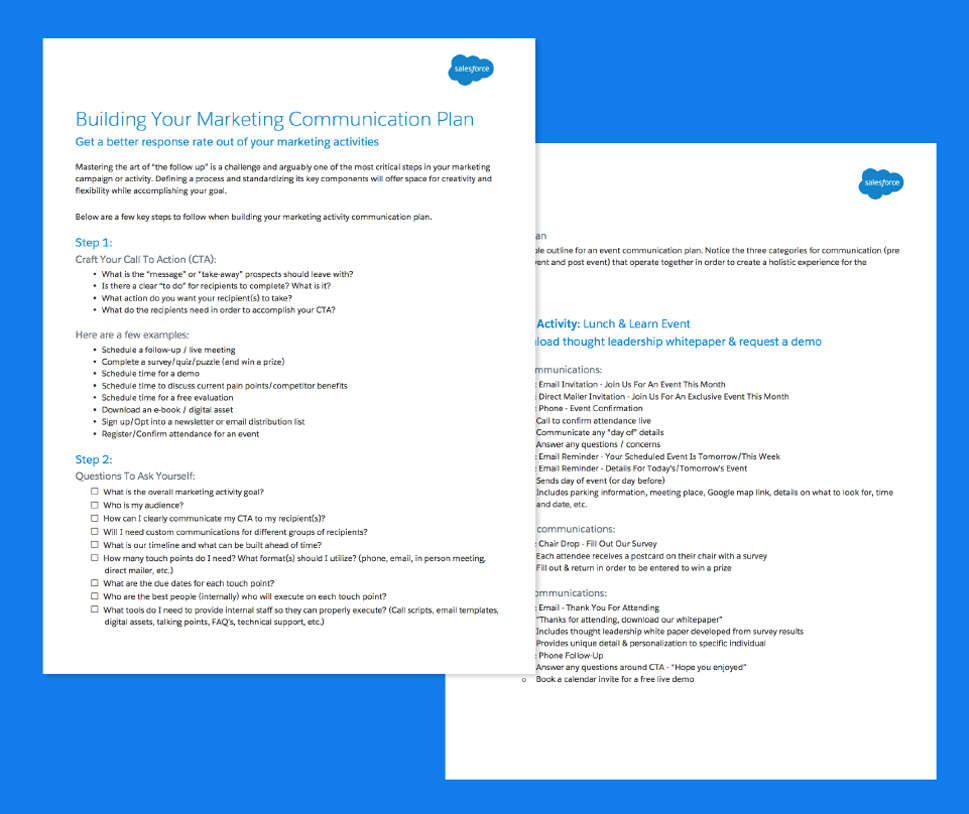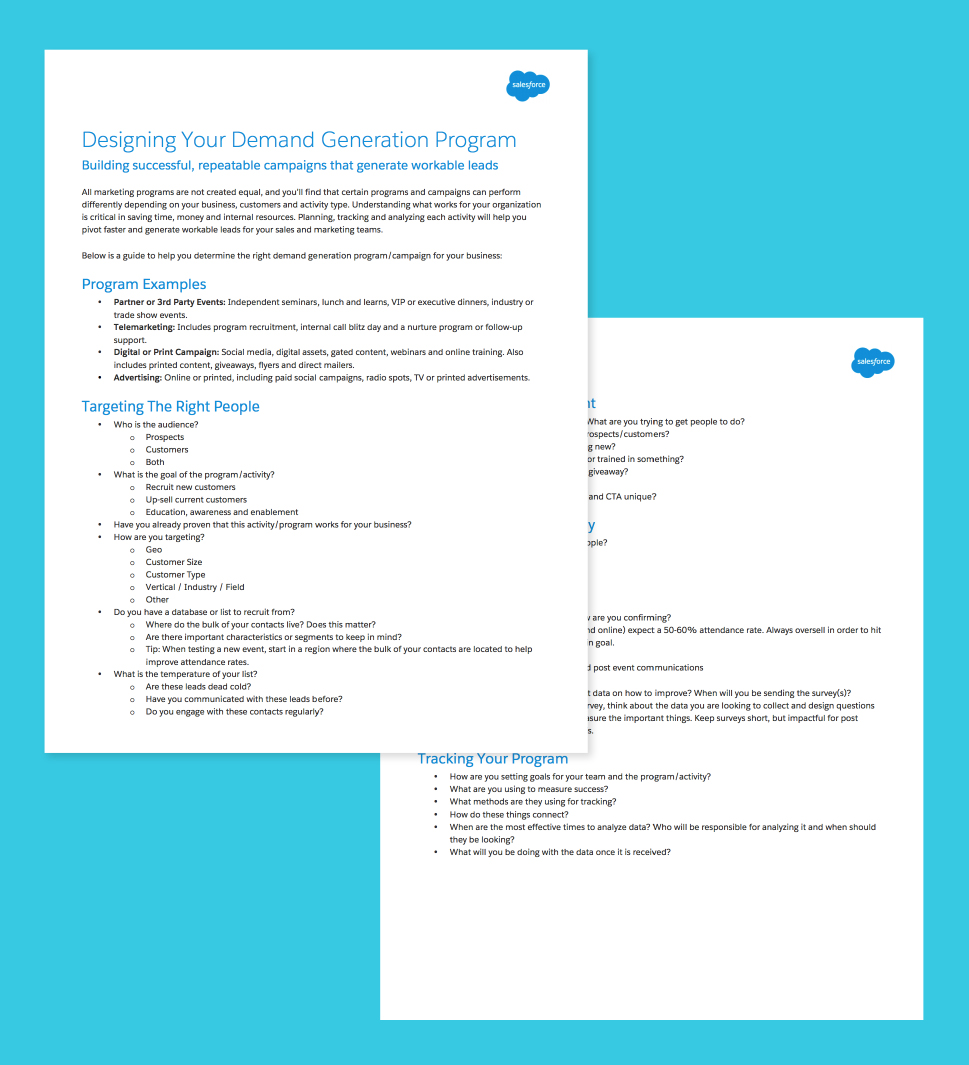EducationEducation
- AppExchange Partners (ISV)
-
Resellers
-
Reseller Marketing Journey
- Get_Organized_Before_You_Get_Started
- Incorporating_Salesforce_Into_Your_Brand
- Crafting_Your_Marketing_Strategy_And_Plan
- Announcing_Your_Salesforce_Partnership
- Build_Sales_Pipeline
- Executing_Lead_Gen_Email_Campaign
- Building_A_Social_Media_Prescence
- Host_a_Learning_Event_About_the_Power_of_Salesforce_Sales_Cloud
-
Reseller Marketing Journey
-
General Topics
-
Topics (A-Z)
- AppExchange_Listing
- AppExchange_Cha
- AppExchange_Tech_Talks
- Branding_Guidelines
- Case_Packs
- Consent Compliance Lead and Project
- COVID_19
- Custom_Metadata_Types
- Customer_Stories
- Digital Marketing Program
- Due_Diligence_Review_new
- Drive_Global_Impact_with_AppExchange_v2
- Education Home Page
- Einstein_Account_Based_Marketing
- Environment_Hub
- GDPR
- Industries
- Innovate_with_Cutting-Edge_Platform_Technology_v2
- Legal_Center
- Lightning_Bolts_Launch
- Lightning_Ready
- Maps_Education_new
- Maps_Education
- MuleSoft
- NewsRoom
- Partner_Ohana_Hub
- Pardot_Integrations
- Partner_Account_Manager
- Partner_Business_Org
- Partner_Communications
- Partner Community Admin Overview
- Partner_Community_User_new
- Partner_Community_User
- Partner_Connect
- Pardot_Resource_Central
- Pardot_B2B_Marketing_Analytics
- Partner_Marketing_Center_new
- Partner_Orgs_new
- Partner_Program
- Partner_Referral_Benefit_Overview
- Partner_Social_Impact_Center
- Partner_Experience
- Partner_Success_Services
- Partner_Support_new
- Partner_User_Groups
- PR_Guidelines
-
Products
- B2C_Commerce_for_LINK_Tech_Partners
- Community_Cloud
- Datorama Education
- Datorama_Education_new
- Einstein
- Einstein_Analytics
- Heroku
- Live_Message
- Marketing_Cloud
- myTrailhead
- Pardot
- Premier_Success
- Quip
- Sales_Cloud
- Salesforce1
- Salesforce_Advantage
- Salesforce_CPQ
- Salesforce_DMP
- Salesforce_IoT
- Salesforce_Platform
- Service_Cloud
- Training_Reseller
- Work_com
- Product_Development_Outsourcer
- Release_Readiness_for_Partners
- Sales_Central
-
Salesforce.org
- CumulusCI
- Education_Cloud_Academy
- Education_Training
- Nonprofit_Cloud_Academy
- Nonprofit_Training
- Salesforce_Advisor_Link
- SFDO_Accounting_Subledger
- SFDO_Admissions_Connect
- SFDO_Consulting_Enablement
- SFDO_Elevate
- SFDO_EMEA_Fundraising
- SFDO_Grants_Management
- SFDO_Insights_Platform
- SFDO_K12
- SFDO_Marketing_and_Engagement_Academy
- SFDO_PMM_Case_Management
- SFDO_Release_and_Roadmap
- Salesforce_Engage
- Salesforce_Orgs
- Salesforce_DX
- Salesforce_Proficiency_Pack
- Scale_and_Access_New_Markets_v2
- SPCMA
- Talent_Exchange
- Training
- Webassessor_for_Partners
- Talent_Alliance
- Partner_Learning_Camp
- Architect_Success_Program
- shareddiscovery
- Datorama_Service_Order_Submission_and_Non-Renewal_Instructions_for_AppExchange_Partners
- Partner_Advisory_Board
- Accredited Professional
- Test_Drive_Education
-
Topics (A-Z)
- AMP

Track 103: Crafting Your Marketing Strategy and Plan
This track will help you develop a complete approach to your marketing your Salesforce Reseller practice. It covers the fundamentals of marketing strategy and planning and guides you through the process of developing and documenting a formal marketing plan.
A well-designed marketing plan will help you address long-term objectives, manage a budget, and ensure your overall marketing approach is focused and productive. It’s also a great way to ensure you access the most funding possible through the Salesforce Co-Marketing Program.
Establishing a marketing plan can be challenging. Salesforce recommends that you work with your Channel Account Manager or a Partner Marketing Manager to help you craft a plan that makes the most of your resources and support from Salesforce.
 Set Your Marketing Objectives
Set Your Marketing Objectives
- The Salesforce Co-Marketing Program is structured primarily to help Resellers with lead generation, so it’s important to focus your marketing objectives on developing leads for your sales teams.
- Rather than ascribing generalized lead generation objectives, try to make them as specific as you can. Consider target verticals, market segments, companies or regions.
Design Your Marketing Program
- Whether you’re up-selling, cross-selling, or reaching new prospects
- Target geographical areas, industries, verticals, companies and job functions
- Any prospective customer lists you have or can easily purchase
- Digital or traditional advertising, including web and print ads and search engine marketing
- Direct marketing efforts like traditional mail and email-blasts
- Telemarketing efforts like call blitzes or lead nurturing programs
- Events such as breakfast or lunch learning sessions, seminars, executive dinners or trade show vents
 The Reseller Marketing Journey includes guidelines and templates for several of these tactical approaches.
The Reseller Marketing Journey includes guidelines and templates for several of these tactical approaches.
Resources for Further Exploration
- “Building Your Marketing Plan” (.pdf)
- Designing Your Demand Generation Program (.pdf)
- Build a GTM Strategy From Scratch (Webinar)

